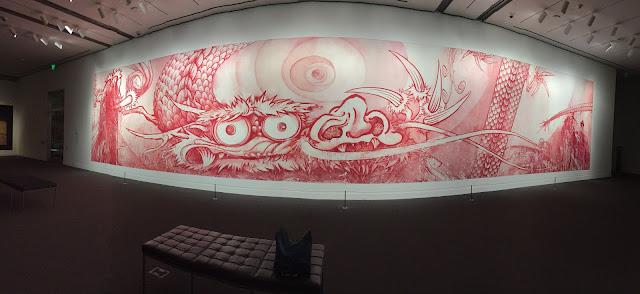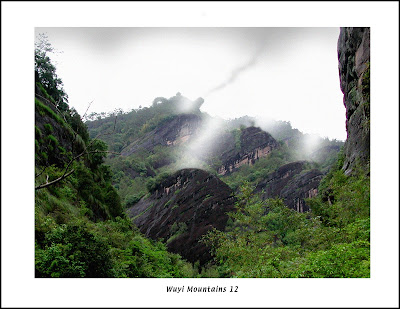 |
| Oops! Forgot to write down what this painting by Murakami is called when I took the photo... |
We started with the fresh strawberries and white chocolate vanilla cream. Vanilla and strawberries both activate the warm receptors in your mouth and nose, while the fat from the white chocolate shuts down the hot receptors. The result is a noticeable enhancement of both the strawberry and the vanilla flavors.* While I am no fan of white chocolate on principle, this was a divine combination—one I will discuss in detail at World Tea Expo in June.
By contrast, the matcha roll itself had little to recommend it beyond its good looks, and the fact that its swirls echoed paintings in the exhibit:
 |
| Takashi Murakami, Dragon in Clouds—Red Mutation: The version I painted myself in annoyance after Professor Nobuo Tsuji told me, “Why don’t you paint something yourself for once?” Photo Evera Lovelace. |
Further, the other ingredients in baked goods dampen the brightness of the flavors of matcha, as they all tend to activate the warm and hot receptors at the expense of the cool and cold receptors activated by brewed matcha. And of course the sugar and salt both inhibit any bitterness. So you want to ask: what is the point of the matcha?
The strawberry cream in the middle was also very muted in flavor, whether because of a lack of strawberries in it, or because of its battle with the matcha cake.
By contrast, the iced ginger green tea with mango was a fascinating success, fascinating because when sipped alone, the mango (mixed in the drink as a puree) disappeared—mango activates warm receptors, where as both the ginger and the green tea, and of course the ice, activate cold receptors. Net effect, as my daughter described it: cool and refreshing!
However, with a bite of fresh strawberry, the mango became more pronounced, and the whole profile of the drink shifted. A great demonstration of the interactions among receptors, their activators and their suppressors, and a fitting complement to the shifting impressions that explorations of Murakami's art and its contexts bring.
Which brings me to another note: have been hard a work creating a new course for the World Tea Academy, this one about creating tea blends (such as this iced tea!). It will be part of a series on blending teas that will include important information about regulations and methods for carrying out the blends by Scott Svihula and Brian Keating.
Hope you are having fun with your tea, too!
===> Available on Amazon in paperback and Kindle: "Three Basic Teas & How to Enjoy Them."








